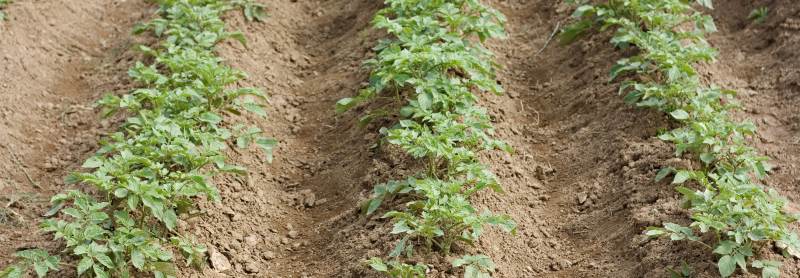Choosing a Plot
Generally potatoes are tolerant to a range of different soils, but given the option, they grow best in loam soil, that is soil that is a mix of sand, silt and a small amount of clay. The plot should be in full sunlight and the soil should be well drained and well dug over the early winter.

It is best to rotate the potato plot each year, planting in the same plot only once every seven years if possible, although for practical purposes three or four years usually suffices. They should be planted about 30cm (12 inches) apart.
If you are not looking to grow potatoes in bulk, they can grow well in big containers. Often growing potatoes in pots produces good flavoured tubers.
Planting potatoes

Many people find that ‘chitting’ potatoes before planting helps to produce a good crop of potatoes. Chitting is when you allow the potato to sprout before you plant it.
If planting in the ground, dig a trench about 10cm deep and plant the seed potatoes with the sprouts facing upwards. Cover with soil, and as the shoots appear above the ground cover them with soil too. If planting in a container, fill the container with about 15cm of soil before planting the seed potatoes, and again cover the shoots with soil until the container is full.
Potatoes should be planted about 30-40cm (12-18 inches) apart. The first early potatoes can be planted from the end of February, the maincrop potatoes from mid March and the second cropping potatoes from early August.
Nurturing your potatoes
 The early crops require plenty of water, particularly during a dry season. This is most important when tubers are starting to form. Keep the soil moist but not saturated.
The early crops require plenty of water, particularly during a dry season. This is most important when tubers are starting to form. Keep the soil moist but not saturated.
It is important not to expose new potatoes to light, as they will turn green and toxic.
Potatoes are susceptible to pests and diseases, particularly if planted in the same plot several years in a row. Slugs and snails may feast on the leaves, and keeping these under control can be difficult. Some people find that barriers of sawdust, eggshells and any other sharp or scratchy material can prevent the slugs harming your plants.
Potato blight is one of the most well known diseases to affect a crop of potatoes. It is most common during particularly wet weather. If blight strikes, there is little that can be done to prevent it spreading, although removing affected leaves and keeping the tubers well-covered with soil may provide some protection. Rotating the potato plot regularly is the most effective way of preventing potato blight.
Harvesting potatoes
Early potatoes are ready for harvesting about 10 weeks after planting, or 20 weeks for maincrop varieties. They are generally ready to harvest when potatoes are the size of a hen’s egg. For early potatoes, this is when the plants begin to flower, for the later crop, this is a couple of weeks after the leaves have withered.
Allow the potatoes to dry in a well-ventilated position for a few hours after harvesting, and then store in paper or hessian sacks as storing in polystyrene can cause the potatoes to rot.






 Looking for our products in a store near you?
Looking for our products in a store near you?
